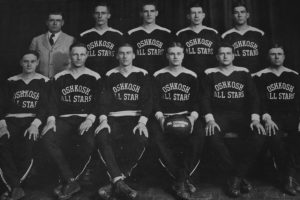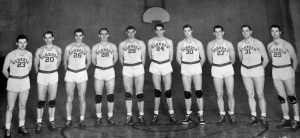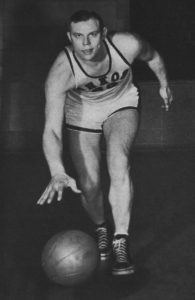Remembering the Oshkosh All-Stars
May 4, 2022
While the Wisconsin Herd of the NBA G League has been welcomed by the Oshkosh community, many people tend to forget that professional basketball in Oshkosh dates back to 1929.
Throughout the 1930s and ’40s, the city of Oshkosh was known across the U.S. for being the home of one of the greatest basketball franchises of the early 20th century, the Oshkosh All-Stars.
The All-Stars were National Basketball League Western Division champions six times, winning the NBL title in 1941 and 1942. Their greatest accomplishment came in 1942, when the All-Stars became world champions by defeating the Detroit Eagles in the World Professional Basketball Tournament.
The NBL featured teams such as the Minneapolis Lakers, Moline Hawks, Fort Wayne Pistons, Rochester Royals and Syracuse Nationals which would eventually find their way to the NBA after the NBL merged with the rival Basketball Association of America.

The All-Stars’ biggest rival was the Sheboygan Red Skins, with Oshkosh winning the all-time series 65-48. The Oshkosh Daily Northwestern compared the games to the Green Bay Packers and Chicago Bears rivalry in football. The Oshkosh-Sheboygan rivalry was the oldest rivalry in the NBL, with the first game between the two teams played in 1934.
According to an Oshkosh Daily Northwestern article from 1979, Arthur Heywood, former sports editor of the Daily Northwestern, approached Lonnie Darling in 1929 with the idea of creating a professional basketball team in Oshkosh. Heywood’s rationale was that if Green Bay could support a pro football team, Oshkosh could support a pro basketball team.
Darling, a seed distributor and salesman for the G.H Hunkel Seed Co., assembled a group of the best college seniors in the Midwest to play exhibition games throughout the year. Dubbed the “All-Stars” by Darling, the 1929 team included future basketball hall of famers Branch McCraden (University of Indiana), Harold “Bud” Foster (UW-Madison), and Charles “Feed” Murphy (University of Loyola-Chicago).
Reggs Hansen, who was a part of a championship team at the Oshkosh State Teachers College (now UW Oshkosh), made the inaugural team in 1929 after a tryout.
Hansen said in an interview with the Oshkosh Daily Northwestern in 1979 that Darling was the owner and coach of the team.
“I think he wanted to get [Bob] Kolf, who coached at Oshkosh State Teacher’s College, but he never did,” Hansen said. “Lonnie would bring in about two or three new guys each game, but it came down to a main group. The guys who had the big reputation always seemed to be over the hill.”
The All-Stars were a barnstorming team in their early years, traveling around the Midwest playing whoever they could. Competition would materialize at night and disappear just as fast the next morning. Many members played for the highest bidding team, and sometimes played for two or three teams at the same time. Almost every player utilized the two-handed set shot, and scores never reached higher than 30. The All-Stars competed against teams such as the Duffy Florals, Chicago Bruins, Goodyear Tires of Milwaukee, the Jewish sponsored House of David from Chicago, the Beloit Fairies, the Fond du Lac Eagles and the Liftschultz Fast Freights.

In the winter of 1934, the Oshkosh Daily Northwestern reported that a “quick, talented guard from Purdue might soon join the All-Stars.” This player was the legendary John Wooden, “the Wizard of Westwood,” who is now widely regarded as the greatest basketball coach of all time. Wooden never ended up in Oshkosh, instead playing for the Indianapolis Kautskys.
One of the most well-known teams that the All-Stars played were the New York Renaissance, an all Black basketball team from Harlem. Oshkosh played the Renaissance in a two-game series in 1936, drawing such large crowds that Darling organized a best of five series for the following year. It was decided between the two owners that the winner of the “World Series” would be named the “world’s champion of basketball.” The All-Stars lost the series 3-2, but the Ren’s owner agreed to extend the “World Series” to a best of seven. Oshkosh won the next two games, taking the title of world champions.
The Rens were not allowed to stay in Oshkosh because they were African Americans, so they stayed at a hotel in Waupaca instead.
Darling founded the NBL, a precursor to the NBA, that same year in 1937 with teams from the old Midwest Basketball Conference. Oshkosh, coached by former All-Star George Hotchkiss, went 12-2 in the inaugural season, winning the Western Division but falling to the Akron Goodyear Wingfoots 2-1 in a three-game series for the NBL Championship. Every NBL championship from this point became a best of five series.
According to a 1977 article from The Advance-Titan, coach Hotchkiss was not in attendance for game three of the NBL Championship because of his job at Northwestern Mutual in Oshkosh. Darling had to wire Hotchkiss from Akron for the starting lineup and formation.
Oshkosh won the Western Division again during the 1938-39 season with a 17-11 record, but fell to the Akron Firestone Non-Skids in the championship series. The All-Stars won the Western Division for the third year in a row the following season but fell once again to the Non-Skids in five games for the NBL title.
The 1940-41 season saw Oshkosh finally break through and take the NBL Championship by sweeping the Sheboygan Red Skins in three games. Hotchkiss was named NBL Coach of the Year in his final season as head coach, and two All-Stars were named First Team All-NBL.
Star players of the All-Stars included 6’5’’ centers Leroy “Lefty” Edwards and Gene Englund. Edwards, who also went by “Cowboy,” was an All-American at Kentucky and went on to be a three-time scoring champion of the NBL with Oshkosh. According to the Oshkosh Daily Northwestern, Edwards is recognized as the player responsible for the creation of the offensive three-second violation, which prohibits a player from standing in the lane for more than three seconds at a time.
Edwards won the NBL MVP three straight years from 1938-40, averaging 16.2 points per game in his best season, 1937-38. During the 1938-39 season Edwards led the NBL in every offensive statistic. Edwards is also credited as the first professional basketball player to score 35 points in a game, doing so against the Fort Wayne Zollner Pistons in 1942. United Press International named Edwards as one of the five best pro players of all time in 1945 but has not been inducted into the Naismith Basketball Hall of Fame, despite being a nominee numerous times.
Englund joined the All-Stars in 1942, fresh off an NCAA Championship with UW-Madison. Englund, the captain of the Badger basketball team, scored a third of his team’s points in the UW’s 39-35 victory over Washington State in the 1941 NCAA Tournament championship game. Englund was named Big Ten MVP that season, scoring a then Big Ten record 162 points. The coach of the Badgers was none other than former All-Star Foster, who coached the team to a 20-3 record after going 8-15 the year before.
Englund joined Oshkosh when he signed a $4,500 contract in the fall and went on to lead Oshkosh in scoring his rookie year. With both Edwards and Englund, the All-Stars won back-to-back NBL titles by defeating the Pistons 2-1 in a best of three series.
Englund said that there were many memorable moments throughout his career in an interview with The Advance-Titan in 1977.
“Beating Indiana for the Big Ten was the one,” he said. “And then beating Washington State for the NCAA title in ’41 followed by the All-Stars winning the World Championship in ’42.”
The biggest accomplishment of the season was their performance at the 1942 World Professional Basketball Tournament, an invitational tournament sponsored by the Chicago Herald American. More than 11,500 fans at Chicago’s International Amphitheater saw the All-Stars take down the Detroit Eagles 43-41 to become World Champions. Oshkosh dominated most of the game, but the eagles launched a comeback to cut the lead to two points with 10 seconds left. A Detroit player threw up a wild shot that rolled around the rim and out as time expired to give Oshkosh its first ever WPBT championship. To reach the final, the All-Stars defeated the Harlem Globetrotters 48-41.
The All-Stars each received a gold watch for winning the 1942 WPBT title. The team took the train back to Oshkosh where they were greeted by more than 4,000 fans at the depot, across from the Oshkosh Public Library on Washington Avenue. The players were hoisted up onto fire trucks and escorted by police and two marching bands all the way to city hall, where they were greeted by Mayor George F. Oaks.
Englund is one of the only players in the history of professional basketball to win a collegiate and pro championship in back-to-back years. Only five NBA players have accomplished this feat, Bill Russell, Magic Johnson, Henry Bibby, Billy Thompson and Arnie Ferrin.
The war years saw the team in decline, although the All-Stars still made the NBL semifinals in 1943 and ‘44. The 1944-45 season was the only one in which Oshkosh did not make the NBL playoffs. Most of this was because Oshkosh’s best player, Englund, was serving in World War II. In the 1945-46 and 1946-47 seasons, Oshkosh lost in the NBL Western Division semifinals.

Gameday in Oshkosh
Professional basketball, or the “pro cage circuit” as it was called because many games were played in cages, was a lot different in NBL than it is today.
The inaugural NBL teams included the Pittsburgh Pirates, Buffalo Bison, Warren Penns, Columbus Athletic Supply, Whiting Ciesar All-Americans, Fort Wayne General Electrics, Indianapolis Kautskys, Richmond King Clothiers, Kankakee Gallagher Trojans and the Dayton Metropolitans.
Later teams such as the Minneapolis Lakers, Moline Hawks, Fort Wayne Pistons, Rochester Royals and Syracuse Nationals would eventually find their way to the NBA.
Stars of the league included Otto Graham, a hall of fame football player, for the Rochester franchise and Press Maravich, the father of NBA legend Pete Maravich, for the Youngstown Bears. Many notable NBA coaches were NBL stars including Buddy Jeanette, William “Red” Holzman and Al Cervi.
In the early years, fans packed into the Oshkosh Recreational Building on Division Street for home games, sometimes standing in the aisles to see their beloved Oshkosh All-Stars. The All-Stars had to play their games during the 1938-39 season at the Merrill School gym because they needed more seats to fit large crowds. The previous season, 20,900 fans attended All-Stars home games, more than half the population of the city. Even the Merrill School gym proved too small for the All-Stars, who moved to the South Park Gym, which could hold 2,300 fans.
Doors to the games, which were played on Saturdays, would open at 6 p.m. and fans would get there as early as 4 p.m. to get tickets. Stores in Oshkosh would close Saturday night because there would be no business during All-Stars games. The All-Stars had so much interest, that they had to have a waitlist like the Green Bay Packers for season tickets. According to an Advance-Titan article in 1977, it cost “two bits” (25 cents) for a seat on the “gym stage” and $2 for a reserved seat.
The night would start with a preliminary game at 6:30, which would pit the Oshkosh Vocational School against other teams in the area such as Green Bay, Neenah, Kimberly and Two Rivers. In 1937, Harry Lund of Clark & Lund took over the preliminary games with his Chris Craft team. After World War II, Lund’s team was recreated as the Hour Tavern, which was sponsored by Chief Oshkosh beer.
The main event started at 8:30, featuring the All-Stars. NBL games lasted 40 minutes and most teams scored a little less than 40 points. The Oshkosh Daily Northwestern used to refer to the All-Stars as the “Point A-Minute Team” because they would score at least 40 points per game. After every basket there was a jump ball at center court, and a special “ball-tosser” would perform the jump ball.
Teams could hold the ball as long as they wanted during the game, and the play clock ran almost nonstop. A foul was not called on a player as long as he made some sort of contact with the ball, and a player was removed from the game if he had four fouls. Designated shooters shot every free throw in the game, no matter who was fouled. The main shots during this era were the layup, the hook shot and the two-handed set shot.
Englund said in a 1977 interview that the game used to be different, starting with the ball.
“A leather ball was used, with sewn seams,” he said. “It was never the same ball twice.”

Englund also said the pace of play was slower and more defensive.
“Kids today are bigger, stronger, jump higher and start playing basketball much earlier,” he said. “You held the ball more, passed it more. There were no dunks or 24-second clocks either.”
During the games, Corky Weisheipl’s six-piece band would play songs such as “Paper Mood,” “Little White Lies” and “Doodlee-Doo” to excite the fans. The Oshkosh Daily Northwestern once reported that Winnebago County clerk Arte Hedtke died of a stroke during a closely contested All-Stars game.
In many NBL games, an all-out brawl would take place on the court between teams after a bad call or disagreement. The Northwestern reported that at least one time, the radio broadcast team faked technical difficulties during a fight on the court.
“All of a sudden there was a fight on the floor,” team scorekeeper Les Dustman said in an interview with the Oshkosh Daily Northwestern in 1979. “Some guy came running out onto the floor and Charley Shipp let him have it. He went ass over teakettle. Ben Laird didn’t know what to say on the air, so I told him to say we were going off the air because of technical difficulties.”
For halftime entertainment, fans would heat pennies and toss them onto the court and watch as children burnt their hands scrambling for the loose change. After the game, fans and players would go down to the Eagle’s Club or Edwards’ Tavern for drinks, dancing and food.
Professional basketball would not become the spectacle it is today until the late 20th century, but the All-Stars were once top-notch entertainment for the people of Oshkosh.
New league rivals NBL
In 1946, the Basketball Association of America, a direct descendant to the NBA and rival to the NBL, was formed. The BAA was started when owners of the nation’s largest arenas, such as Walter Brown of the Boston Garden, wanted professional basketball in major cities. They also wanted more offense to attract more fans, and the owners decided to eliminate zone defense.
In its first season, the BAA’s Eastern Division included the Washington Capitols, the Philadelphia Warriors (now the Golden State Warriors of the NBA), the New York Knicks (same as the current NBA team), the Providence Steam Rollers, the Boston Celtics (same as the current NBA team) and the Toronto Huskies. In the West, there was the Chicago Stags, St. Louis Bombers, Cleveland Rebels, Detroit Falcons and the Pittsburgh Ironmen.
The arrival of a second major basketball league created a bidding war for players between the NBL and BAA. The more established NBL still attracted the biggest college stars such as DePaul University’s George Mikan. Bill Brown from the University of Maryland was once drafted by the Philadelphia Warriors but instead chose to play for Oshkosh, since it was known as a premier basketball city in the Midwest.
The NBL would have gone extinct if not for Mikan, who signed with the American Gears of Chicago for an NBL record contract of $60,000. Mikan (6’10”), one of the tallest players in league history, burst onto the “pro cage” scene, making all NBL First Team his rookie season and winning the 1947 NBL title with the Gears.
The Chicago Gears folded the next season and Mikan moved to the Minneapolis Lakers, where he stayed for the rest of his career. Mikan and the Lakers defeated the All-Stars in the 1948 NBL playoffs and defeated the Rochester Royals in the finals.
Mikan would later become the first superstar of the NBA, paving the way for big men like Wilt Chamberlain or Russel. Known as “Mr. Basketball”, Mikan changed basketball forever with his rebounding, shot blocking and the skyhook shot. Mikan, whose defensive play forced the NBA to create a goaltending rule, was inducted into the inaugural Naismith Basketball Hall of Fame in 1959.
After the 1948 season, Minneapolis, Indianapolis, Fort Wayne and Rochester left the NBL for the BAA, leaving the older league without its most profitable player and four of its best teams. There was talk of a merger between the two leagues, but the NBL continued for the 1949 season.
In the final NBL season, the Oshkosh All-Stars won the Western Division crown but were swept by the Anderson Duffy Packers in the championship series. After the season, the NBL and BAA agreed to a merger, with the BAA taking the Syracuse, Moline, Waterloo, Anderson, Denver (the original Denver Nuggets) and Sheboygan teams. The latter four teams folded after one season in the league. After the NBL-BAA merger, the new league rebranded itself as the NBA.
Darling tried everything he could to get the All-Stars into the NBA but had no such luck. He proposed a move to Green Bay or Milwaukee, but the BAA told him that he had not met the deadline to enter the league. According to the Oshkosh Daily Northwestern, Darling was heartbroken that his team was not included. He suffered from heart attacks and had suicide attempts, later passing away from heart failure April 19, 1951.
After the merger, Englund played for one season with the Boston Celtics before retiring to become a Big Ten and NBA referee. Englund died Nov. 5, 1995, in Oshkosh.
The All-Stars continued as the Oshkosh Stars from 1950-53 as a semi-pro team. A reunion game was held in 1960 between the All-Stars and the Sheboygan Red Skins. Over 3,000 fans watched Englund, and the All-Stars fall to the Red Skins 45-41 at the Sheboygan Armory.
As for the former NBL teams in the NBA, Moline moved to Milwaukee and played as the Milwaukee Hawks from 1950-55. While in Milwaukee, the Hawks drafted future hall of famer Bob Pettit. The franchise then moved to St. Louis and then Atlanta, where they have remained ever since.
The Fort Wayne Pistons moved to Detroit, where they are still the Detroit Pistons. The Rochester Royals moved to Cincinnati where they would draft future Milwaukee Buck and hall of famer Oscar Robertson. Eventually, the team would move to Kansas City (to be renamed the Kings to avoid confusion with the MLB team) and then to Sacramento.
Minneapolis would move to Los Angeles where they would become one of the winningest franchises in NBA history. Finally, the Syracuse Nationals moved to Philadelphia where they would become the 76ers.
This year the NBA is celebrating its 75th Anniversary. Unfortunately, the NBA counts its BAA years as a part of its history, but not any part of the NBL.
While all of the Oshkosh All-Stars have died, their legacy in the foundation of professional basketball as we know it today will never die.














